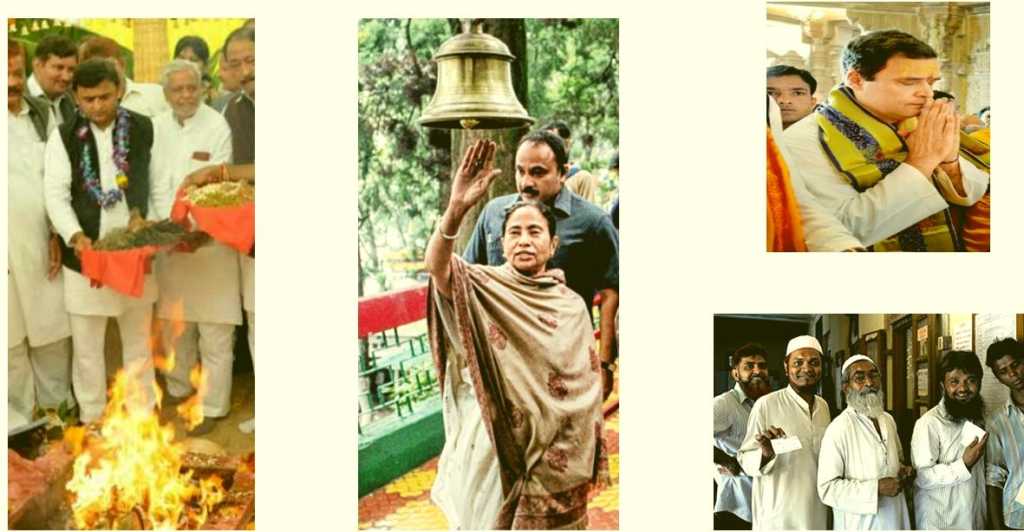2017 was a very significant year in the political history of India. The BJP continued its winning streak all through the year and it ended the year on a high note when the party managed to retain Gujarat despite 22 years of anti- incumbency and also wrest the state of Himachal Pradesh from the Congress. The most significant victory of course was the one in Uttar Pradesh where the party and its allies were able to win over 320 seats. BJP’s absolute domination has led to a paradigm shift in the way parties approach elections. There are shifting trends in voting patterns as well as a change in campaigning styles by the “secular” parties.
The most significant change in the subsequent campaigning after the UP elections was the abandonment of Secularism and adoption of soft Hindutva by the opposition.
The British policy of divide and rule has successfully been used by Congress and its allies to exploit existing caste and religion fault lines and keep the Hindus, Muslims and the various Hindu Castes divided among themselves. But the strategy seems to be losing its sheen. This was quite evident during the UP elections when the secular alliance of Congress and Samajwadi Party had to suffer a crushing defeat at the hands of the BJP. Not just this, Mayawati’s tactic to give 99 tickets to Muslim tickets to Muslim Candidates fell flat on its face. It was easiy discernable that Hindus emerged as one solid vote block and that became a major headache for the secular parties.
Gujarat became the first lab to test Secular Parties’ newfound love for Hindutva. Rahul Gandhi went on a temple spree to woo Hindu voters and went as far as to claim that he is a janeudhari Brahmin, a sharp contrast to Nehru who believed that Hinduism should not be allowed to thrive in the country. Also, neither Rahul nor any Congressmen made even a single reference to the 2002 Gujarat riots, which used to be their go-to word in Gujarat. Needless to say, that Rahul Gandhi felt no need to visit any Dargah or Mosque during his campaign. This pro-Hindu tilt was ironical to say the least considering the fact that the UPA government was instrumental in coining the term “Saffron Terror”. Taking a cue from Congress, many secular politicians are now following the suit and adopting the soft Hindutva approach. Regional leaders like Akhilesh Yadav and Mamata Banerjee who heavily banked on Muslims are now playing the soft Hindutva card. Mamata Banerjee even visited an ashram in the hope that some divine intervention will thwart the growth of BJP and prevent it from making inroads in her bastion. This visit comes in the backdrop of Sabang by- poll where the BJP won 18.4% vote share compared to the paltry 2.6% votes last year.
A sharp reversal in the political narrative can be observed in the instances cited above. Instead of appeasing the minority community, the political parties are now leaving no stone unturned in wooing the Hindu community. The parties which chose to remain mum on many Hindu related issues, fearing that they might upset their minority votebank are now not hesitant to side with Hindus and behave as if they are the only well-wishers of the majority community.
It seems now that it is going to be a battle between those who are right-of –center and those who are center right or the liberal right.
But herein arises a question:
Have Muslims been reduced to Non–Entities in the political space?
Well, not exactly. Although Political Parties have (for now) stopped stressing on Muslims and Muslim-centric issues, their zealous drive to pitch for pro-Muslim measures may have reduced, but it doesn’t imply that Muslims have been reduced to nobodies in the political arena. For starters, India has a sizeable Muslim population of 14% and it is also home to 10%of the Muslims in the world. So, it is not entirely possible for political parties to ignore them. This is quite evident from the fact that even the BJP has softened its tone towards the Muslims.
But there is another interesting change.
Due to the awakening of the Hindus and national pride in the recent years, the political parties have now realized that elections could not be won by merely creating a rift between different castes and appeasing Muslims and handing out sops to them. Also with the blurring of caste lines among Hindus it has led to them voting en bloc towards a single party that represents them thus undermining the effect of the Muslim votebank which has been traditionally voting against the BJP. But Gujarat also showed that Caste Fault lines can still be exploited and that is going to be BJP’s main challenge in 2019.
With the rise of Hindutva politics, Muslims are now no longer willing to play blind voters to the so called Secular parties they have so far been voting for. There has been a deep realization among Muslims that political parties have stopped at mere symbolism in supporting their cause.
Muslims are now forming political groups that exclusively serve the purpose of uplifting the community. The last Uttar Pradesh election saw the rise of Peace Party (which won 4 seats). The last two Assam assembly elections saw the rise of the All-India United Democratic Front (AUDF, which won 18 assembly seats), and in Tamil Nadu there is the Manithaneya Makkal Katchi, a political front of the activist Tamil Nadu Muslim Munnetra Kazhagam (TMMK), which won two assembly seats in alliance with the AIADMK in the 2011 assembly elections.
This does not add to much their political clout, but the clear impact of such groups can felt in states like Kerala and Assam where they command clear power by being among the top three parties of the states in terms of vote-share or seats.
So, now it remains to be seen how the Indian polity will take shape in the coming years!
